Growing up in a small Thai village, I learned to make Pad Thai the way my family and neighbors did—using simple ingredients and balancing flavors just right. This shrimp Pad Thai recipe is like a taste of home for me, and I’m excited to share that same feeling with you. It’s authentic, easy to make, and full of the flavors I grew up with.
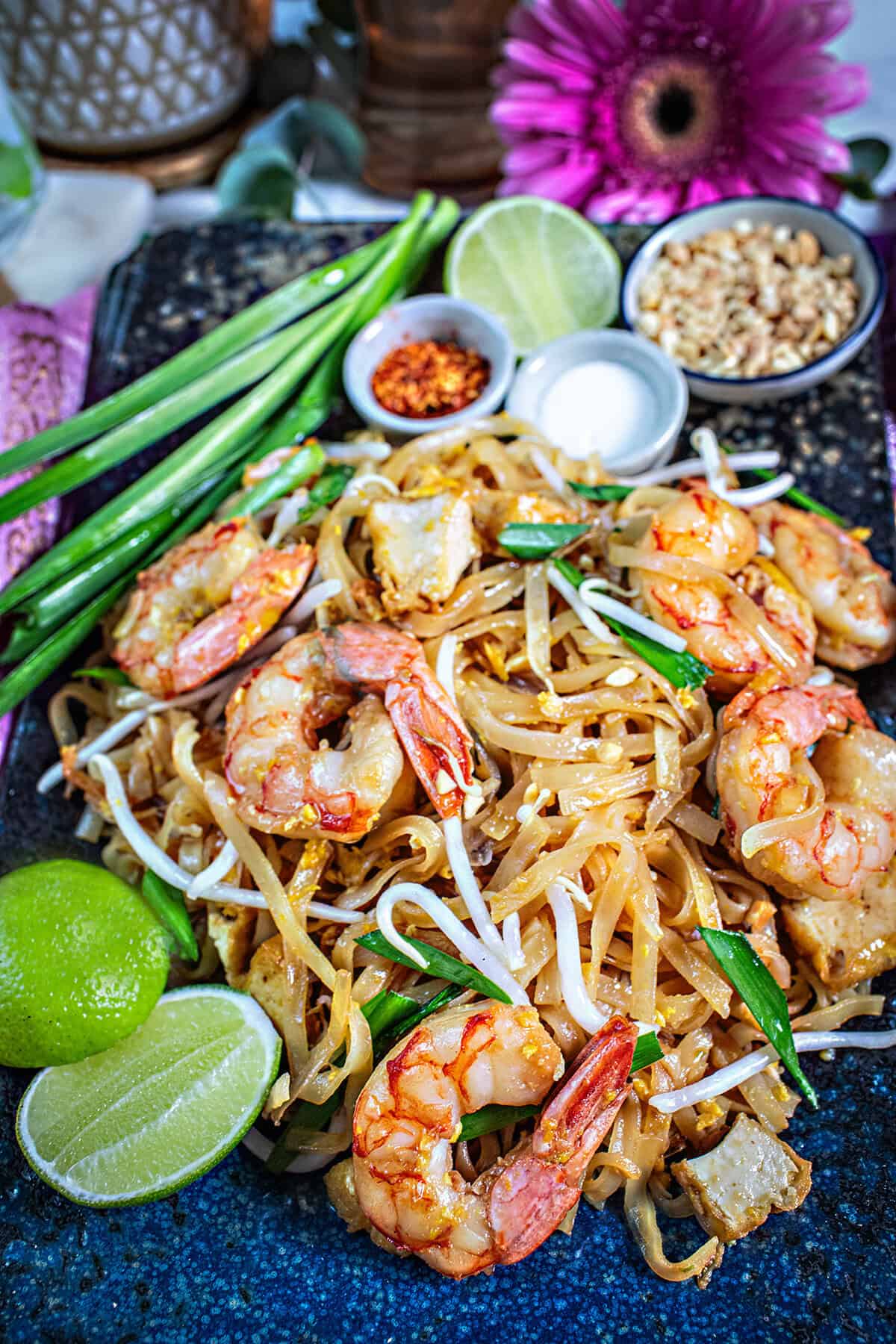
After teaching so many Thai cooking classes, I’ve seen what works best for home cooks and put that know-how into this shrimp Pad Thai recipe. I’ve crafted each step so you can make an amazing, restaurant-quality Pad Thai right in your kitchen. This recipe will help you nail those rich, tangy, and savory flavors, even if it's your first time.
Learn more about tamarind, palm sugar, and dried shrimp in these helpful blog posts. These are all the important ingredients that give Pad Thai authentic flavors. Make your own homemade Pad Thai sauce using this recipe. Go the extra mile and make your own tamarind paste from the pulp.
For more tasty Thai noodle dishes, try these recipes as well. Pad Mee Korat is a spicy noodles dish from the Isaan region, the Northeastern region of Thailand. Or a simple but adaptable light Pad Mee noodles dish using simple ingredients. Both are extremely flavorful recipes.
Jump to:
Why this Shrimp Pad Thai Works
- Pad Thai is delicious and has all the savory, salty, tangy, and umami tastes. All in one satisfying and highly addictive bite!
- It's mild with the option of added heat using red pepper flakes.
- You can adapt the recipe for a vegetarian version by making vegetable Pad Thai. It's super easy. Just omit shrimp and eggs.
- You can make the sauce separately or beforehand to save time and use the sauce for other stir-frying recipes!
- There are tons of great options for adding vegetables! Try broccoli, carrots, green or red bell peppers, pea pods, baby corn, jalapenos, or green beans.
What is Pad Thai?
Pad Thai is an incredibly tasty stir-fried rice noodle with pleasantly addictive flavors that are hard to forget—and super addictive. It's a sweet, salty, and tangy dish filled with silky, savory rice noodles seasoned with palm sugar, tamarind concentrate, and fish sauce. Authentic Pad Thai is typically mild but can be spicy by adding chili peppers for heat.
Pad Thai as an International Dish
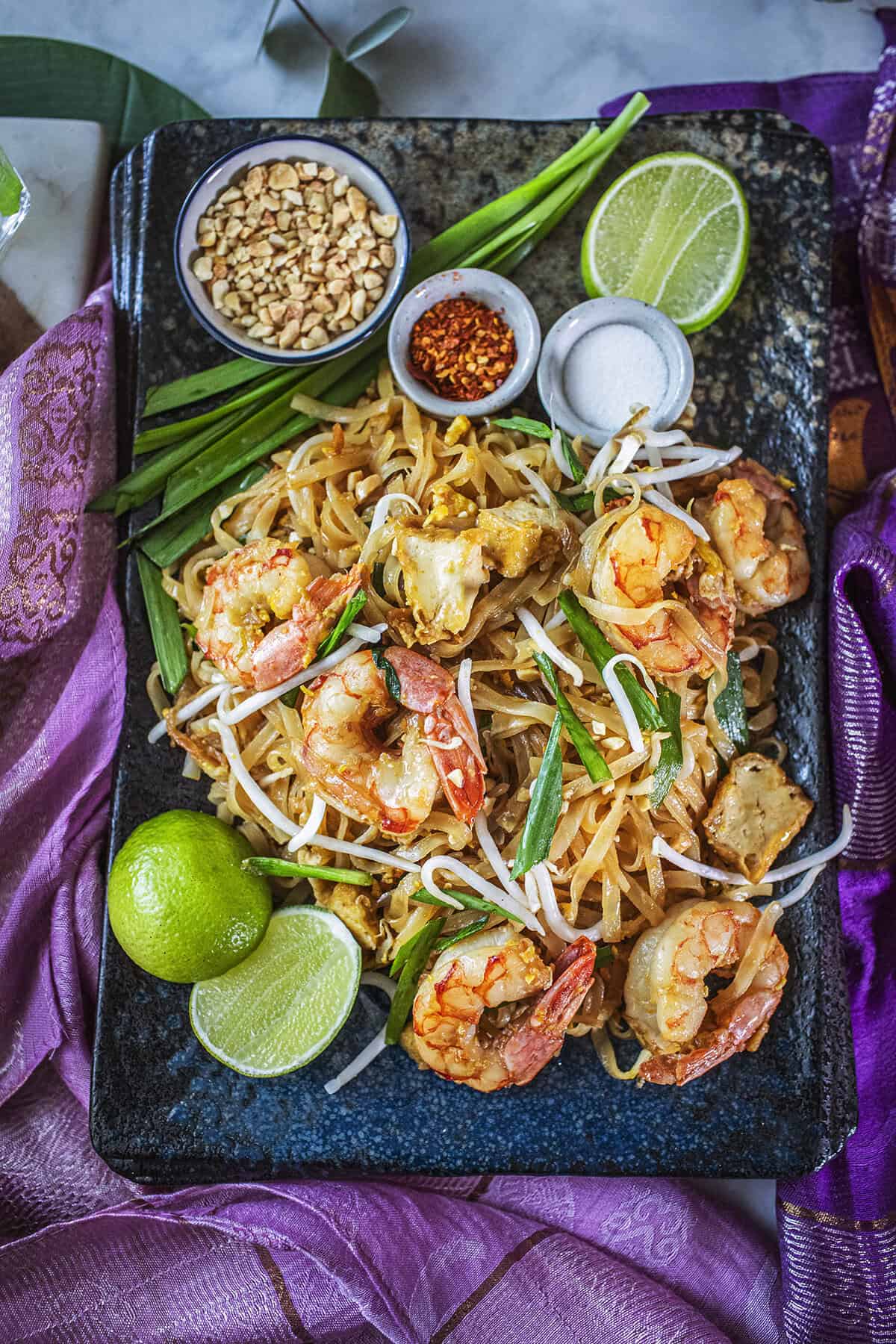
Pad Thai is an extremely popular rice noodles dish in Thai cuisine. It has become so popular that I'd be shocked to walk into a Thai restaurant in the United States and not see Pad Thai on its menu.
You can even find it in other non-Thai restaurants. That's how popular it has gotten! Though I question the authenticity of some of those restaurant-style pad Thai recipes if I'm being honest here! (;
In Thailand, Pad Thai is served all over by street vendors and sit-down restaurants. The shrimp version is most common and popular with the locals.
Shrimp Pad Thai Ingredients
Below are the dry and fresh ingredients for making a great Pad Thai recipe.
Some ingredients may seem intimidating, but your best bet is to find an Asian Market near you or order online. I know it can be disorienting walking into a new store you don’t know.
Think of it this way: pretend you are in a new country and exploring a new grocery store! More often than not, the store owners are eager to help you find the items you need. (:
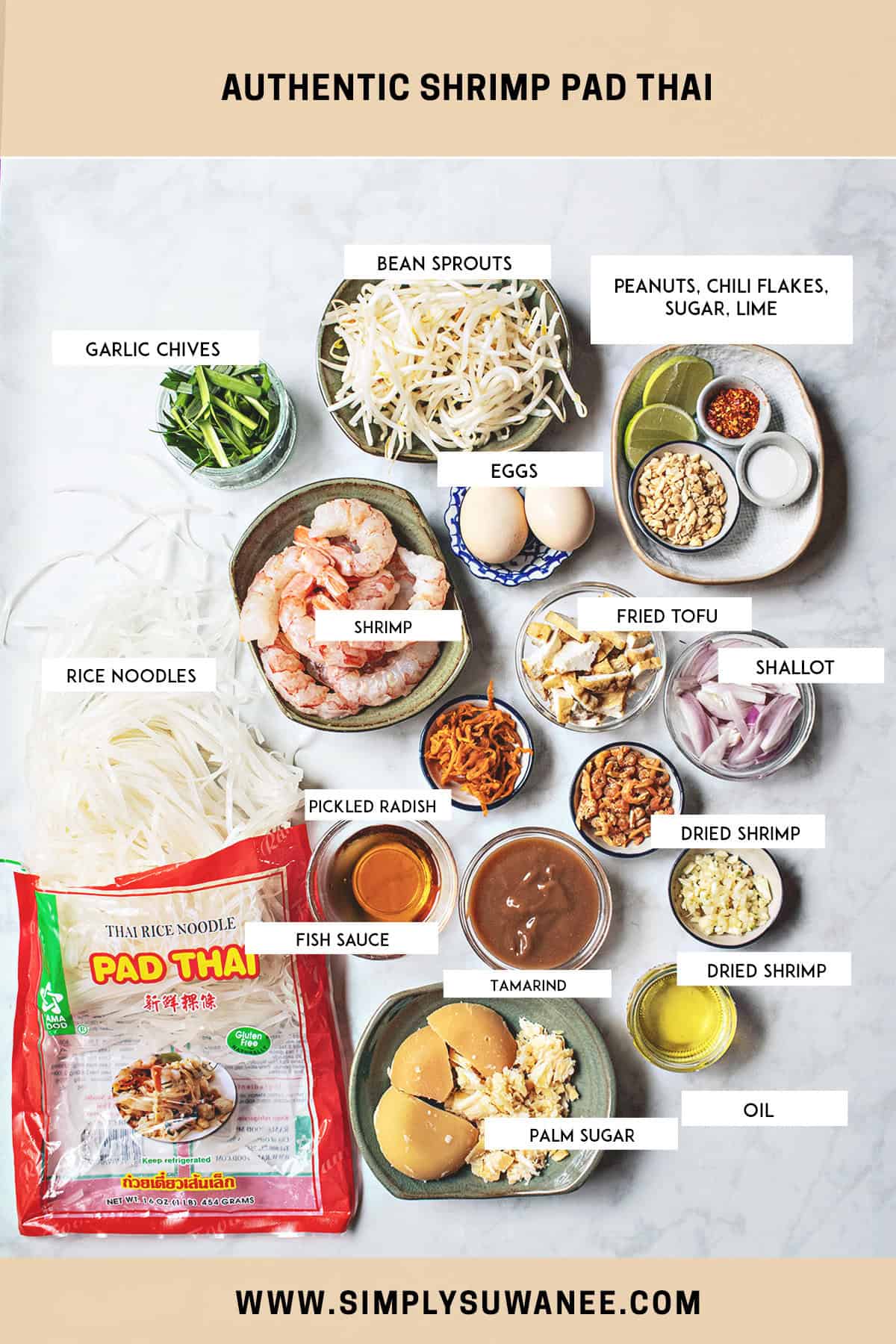
- Rice noodles. Find fresh noodles sold in the refrigerator section labeled "Pad Thai Noodles," or find dry flat rice noodles in a packet. Cook the dry noodles according to package directions.
- Tofu. You can use fried tofu sold at the Asian market in the refrigerator packed in a plastic container, or you can make your own tofu using this recipe. Make your crispy tofu by deep frying, baking, or using an air fryer baked. Cook until firm and golden brown. Use the firmest tofu you can find for this.
- Raw shrimp. Substitute any protein, such as chicken, beef, or pork. Those will need a longer time to cook. Shrimp doesn't take long to cook. When using other proteins, make sure they are cooked thoroughly before moving on to the next step.
- Eggs. Chicken or duck eggs are great for this. Skip the eggs if you have egg allergies.
- Fresh bean sprouts. They add crunchy, fresh textures to the soft and sweet chewy rice noodles.
- Shallots. They offer more authentic and fragrant flavors than onions, but if you need to, use purple or red onion.
- Garlic. For the added flavor when sautéing before adding the shrimp.
- Garlic chives are used in authentic Pad Thai. Green onions work fine as substitutes, as garlic chives are not always available in Asian and American grocery stores.
- Crushed peanuts. Do not use peanut butter. It's not for this recipe. Save it for Satay instead!
- Oil. Use high-smoking-point oil that can tolerate high heat in cooking, such as vegetable, canola, avocado, coconut, or peanut oil.
The Right Kind of Pad Thai Noodles
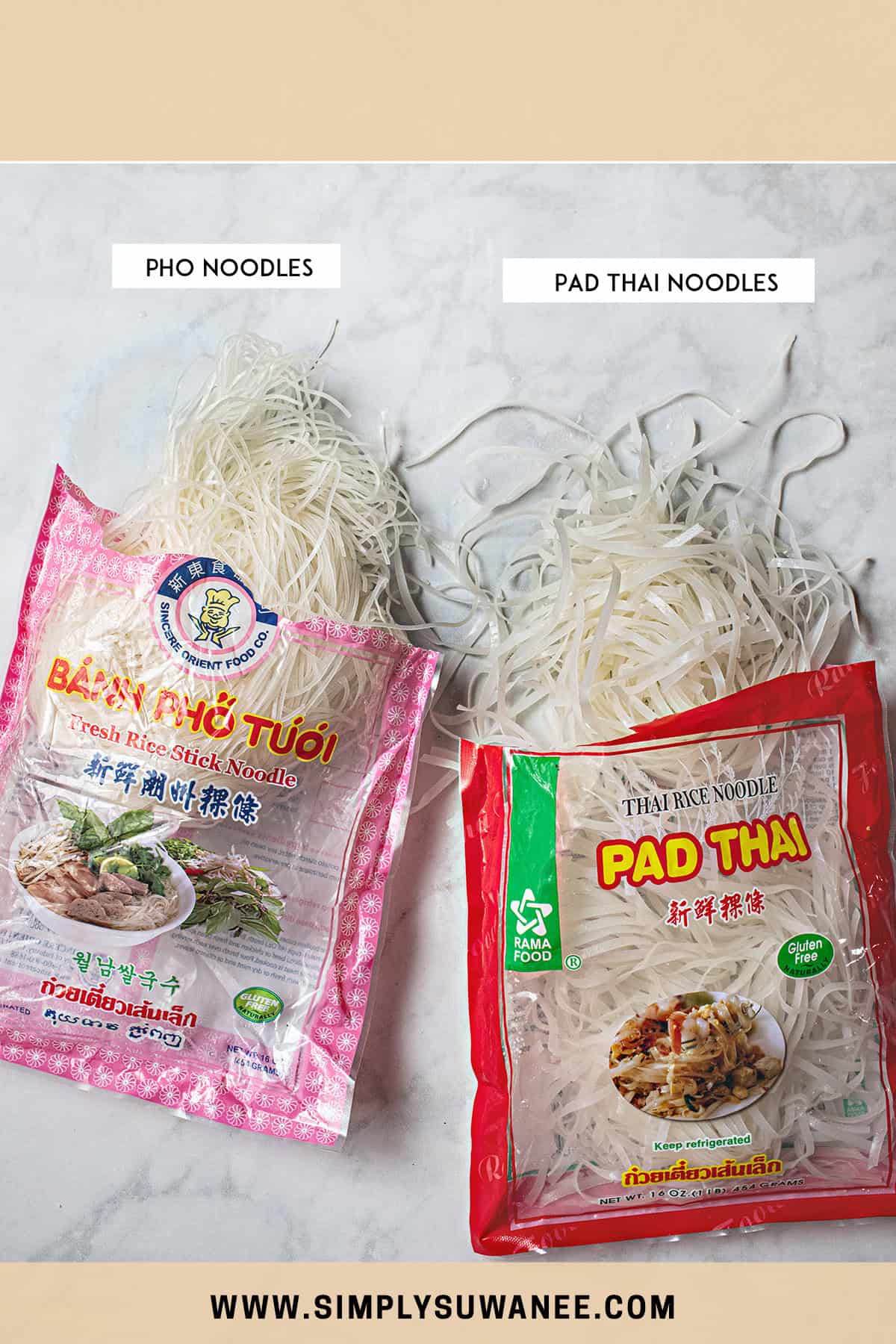
Picking the right Pad Thai noodles can be tricky. Traditionally, Pad Thai uses wider rice noodles, now often labeled as “Pad Thai” noodles in American stores. I’ve included a comparison photo here to help. One shows the correct noodles for this recipe, while the other is a thinner noodle typically used for Pho (often mistaken for Pad Thai noodles). If you can’t find the wider noodles, Pho noodles can work, but they can get clumpy—just soak them until al dente to avoid sogginess.
Unique Ingredients for Authentic Pad Thai
The ingredients pictured below are essential for authentic Pad Thai and bring an incredible depth of flavor. Use this image as a handy reference when searching for these specialty items at Asian markets!
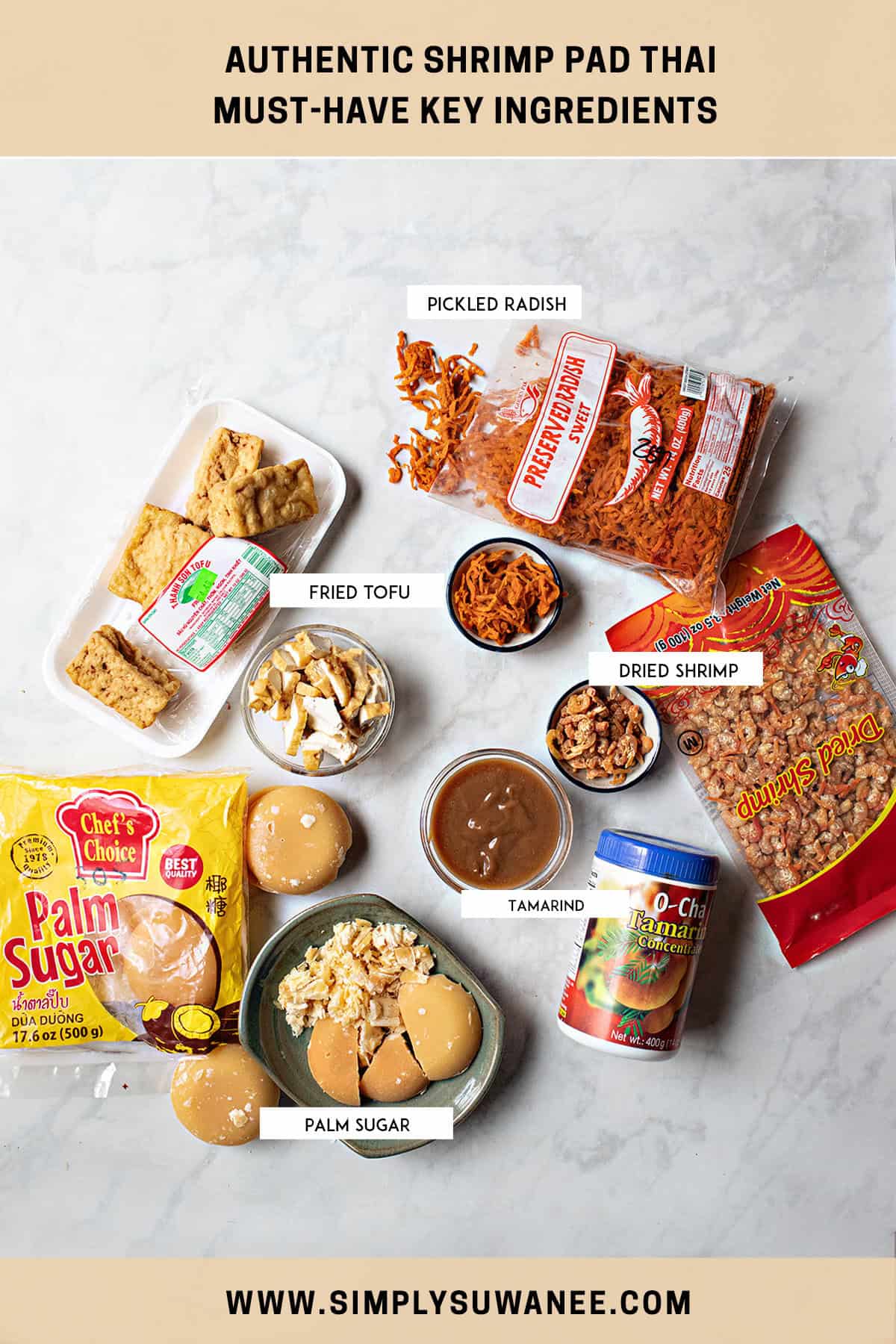
- Pickled radish. (Huah Chai Bpoh). They are salted, preserved, and dried radish or daikon. Use only the sweetened kind, not the salted package. These can be found at your local Asian grocery stores packed in a bag. Some are refrigerated, and some aren't, but after opening a bag, always refrigerate it. It will keep for months or until the next time you make your Pad Thai again.
- Tamarind concentrate. Also called tamarind paste, it is essential in making authentic Pad Thai sauce. Learn how to make your own tamarind paste here.
- Palm sugar. Adds a mellow sweetness. Look for soft paste version for ease, or shave small amounts from solid palm sugar pucks at the Asian markets. Or you can substitute brown sugar.
- Dried shrimp. These salted dehydrated shrimp add extra umami flavors, so don't skip out. Find them in the refrigerated section at Asian markets.
- Fried Tofu. Use deep-fried tofu for best results.
How to make Pad Thai Noodles with Shrimp
Step 1: Prepare the Noodles. Soak fresh noodles in a large bowl of water until soft. Drain and set aside. If you’re using dried noodles, follow the package instructions—they usually need to soak in hot water to soften. Check out my tips below for avoiding mushy noodles! For this recipe, I used fresh noodles (see my preferred brand below).
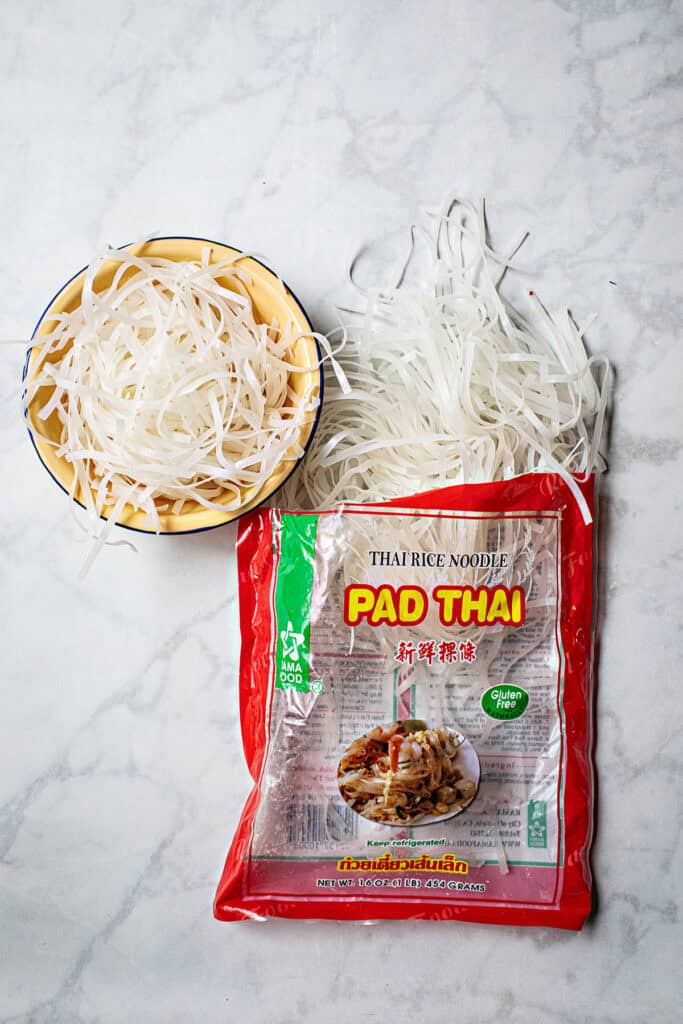
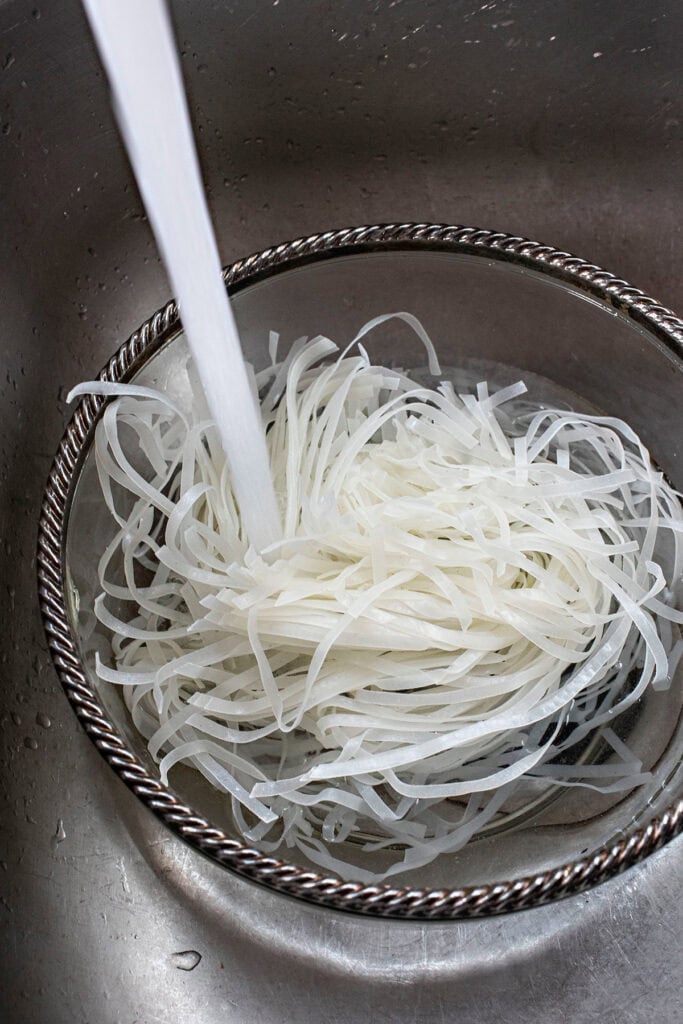
Step 2. Make the Pad Thai Sauce
In a small saucepan, combine palm sugar and fish sauce over medium-high heat, stirring until the sugar dissolves. Add tamarind paste last, bring to a gentle boil, then remove from heat and let cool. Set aside for later.
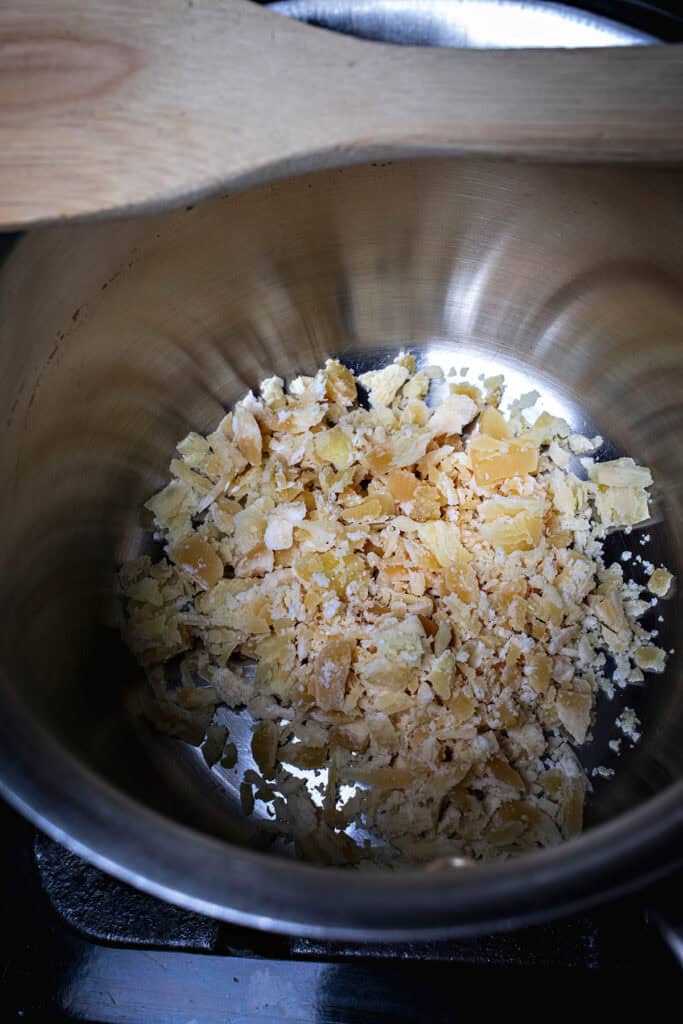
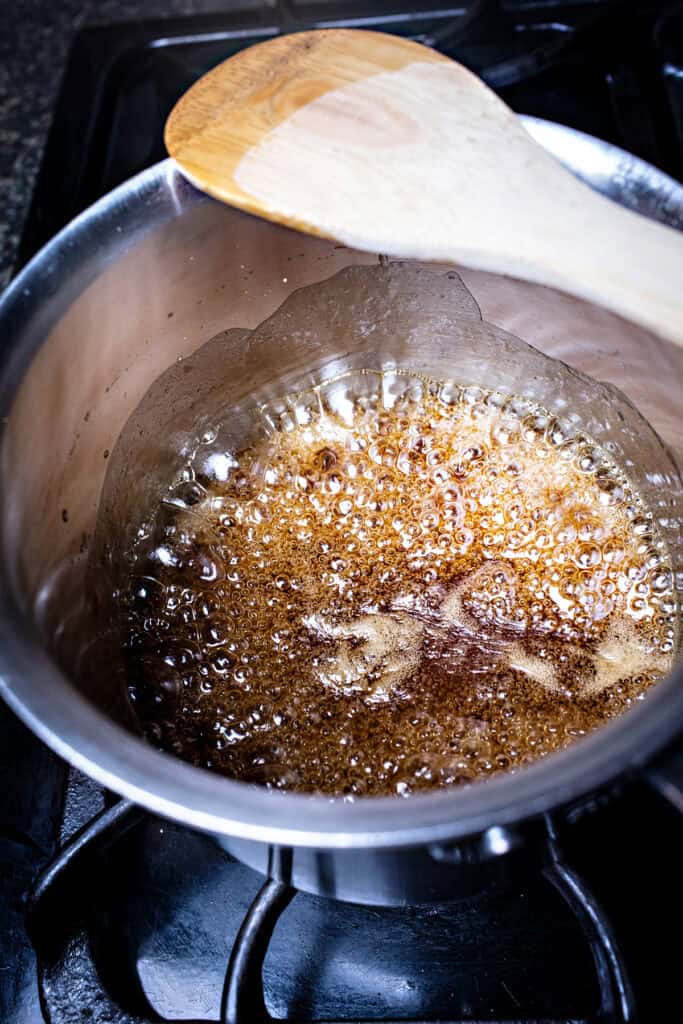
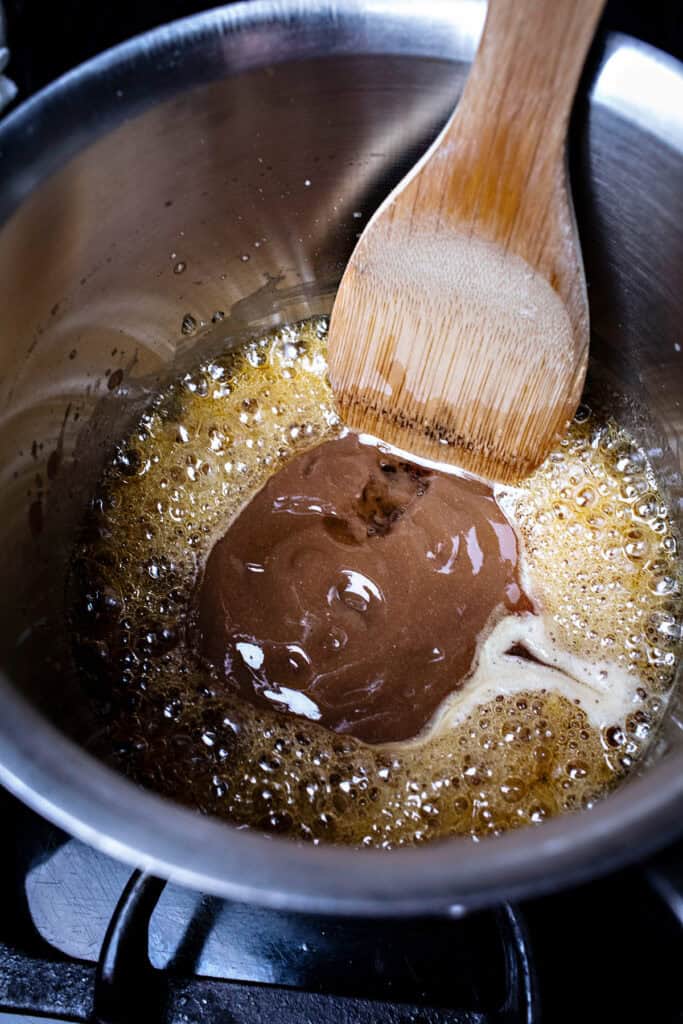
Step 3: Sauté the Aromatics. Heat a wok or large skillet over medium-high heat, adding oil once hot. Sauté garlic, shallots, dried shrimp, and pickled radish for 1-2 minutes until fragrant and lightly golden. Add the tofu and stir-fry briefly to crisp it up slightly.
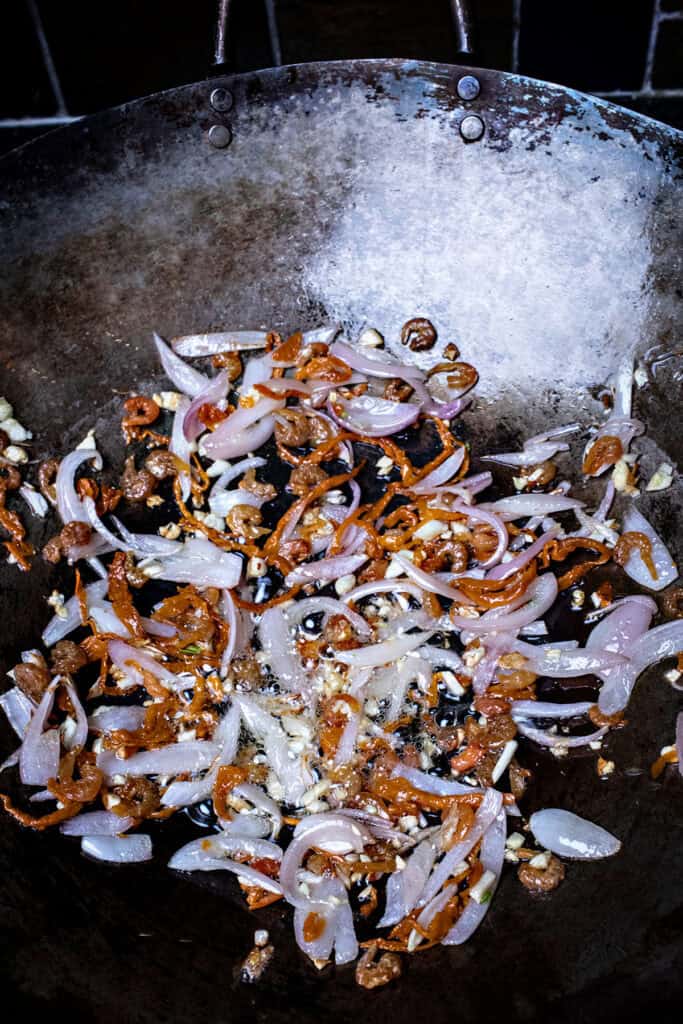
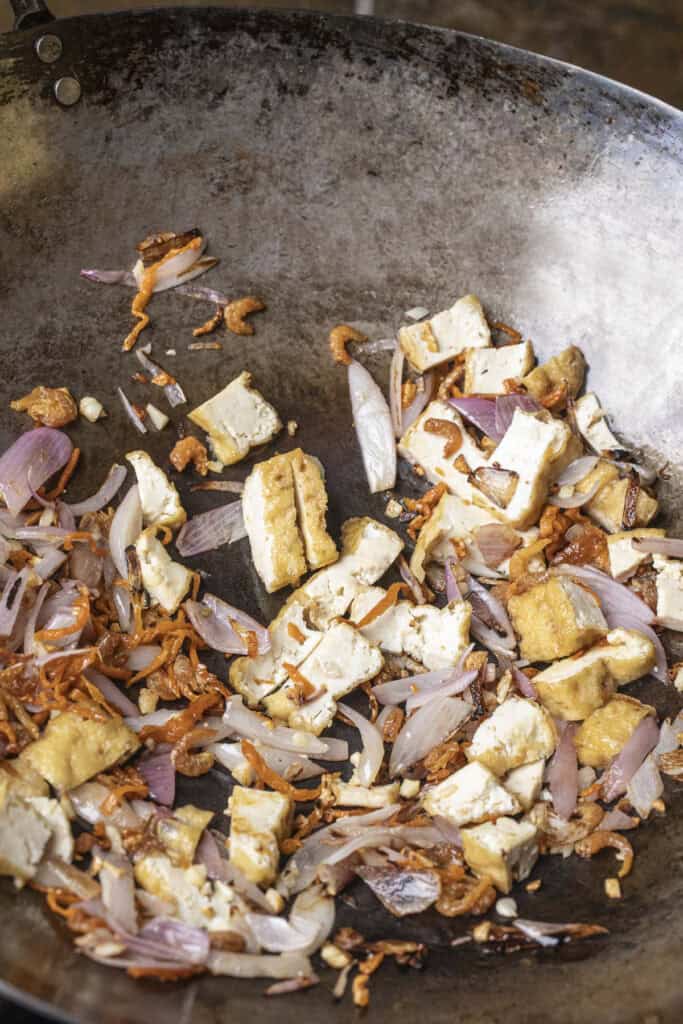
Step 4: Cook the Protein. Add the shrimp to the wok and cook for about 2 minutes until they turn pink. Move everything to one side of the wok, add more oil, and crack in the eggs. Lightly scramble them, let them cook until they’re just set, and keep them in chunky pieces to add texture.
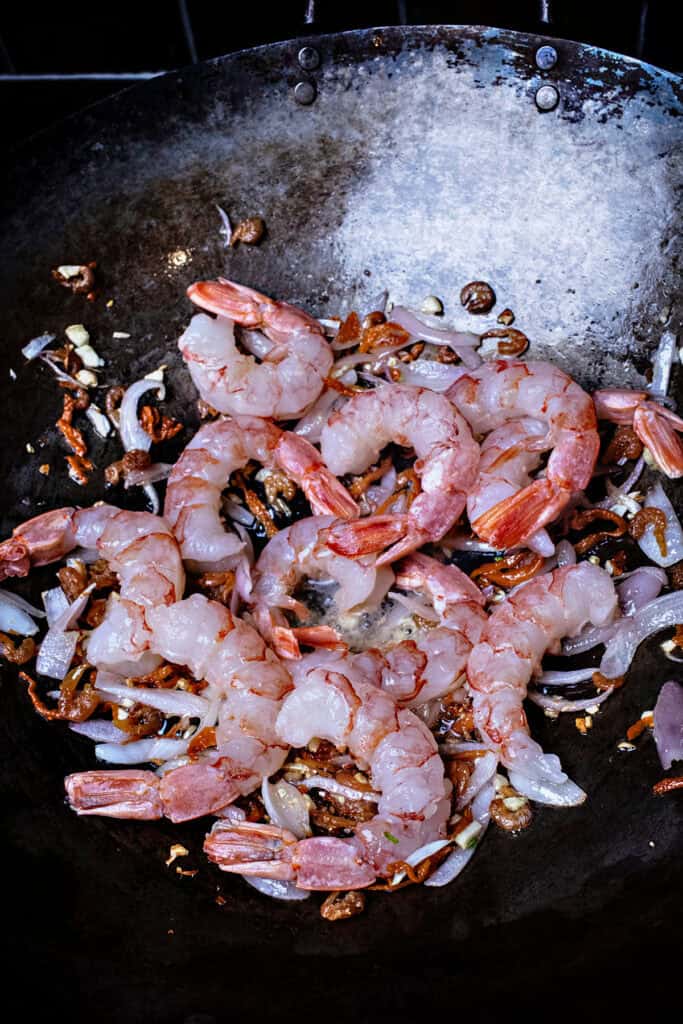
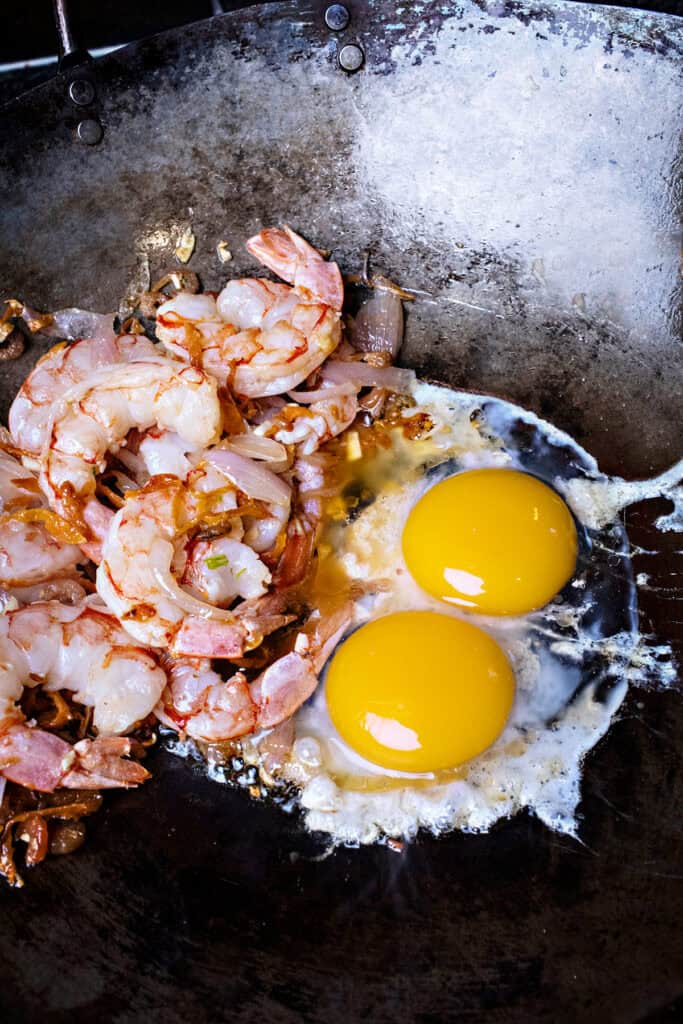
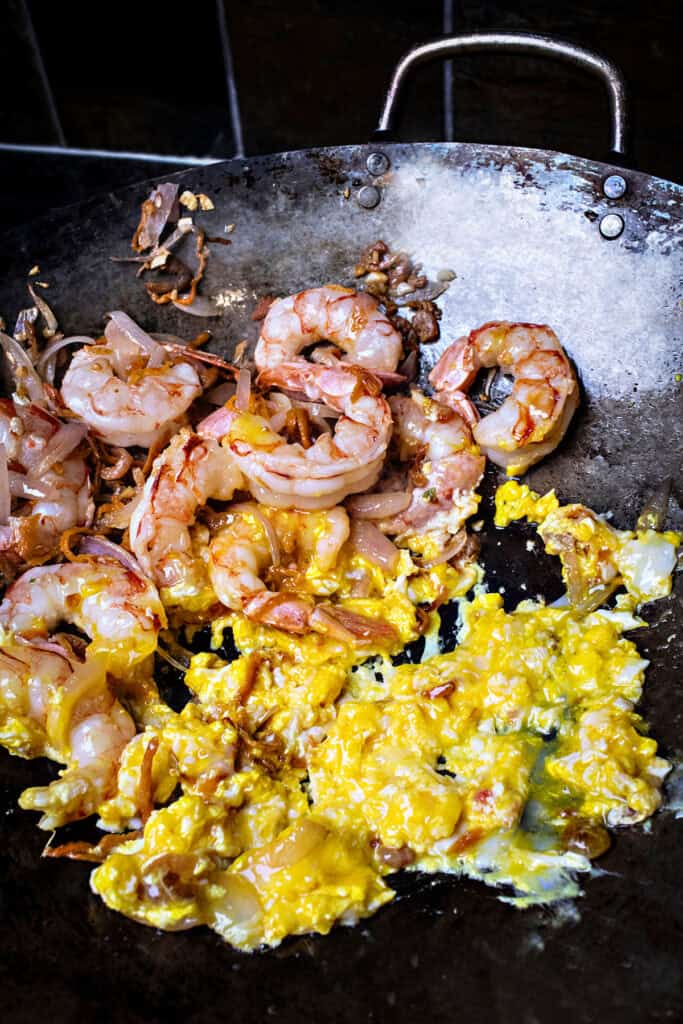
Step 5: Add the Noodles. Toss in the soaked rice noodles, stirring well to combine everything. Let cook for about 2 minutes, making sure the noodles are spread out to avoid clumping.
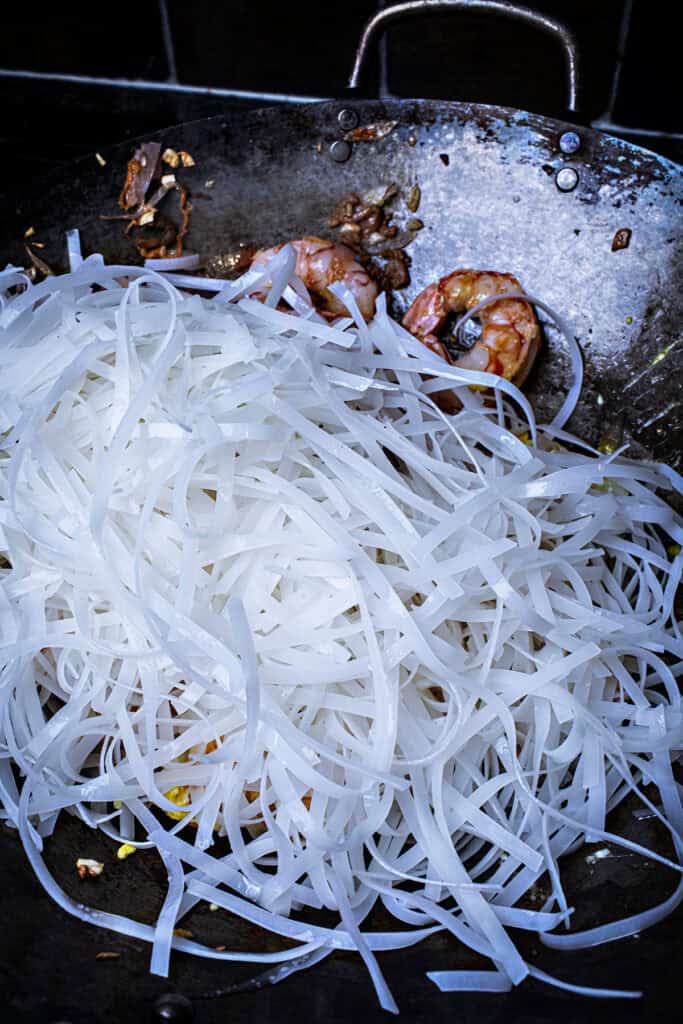
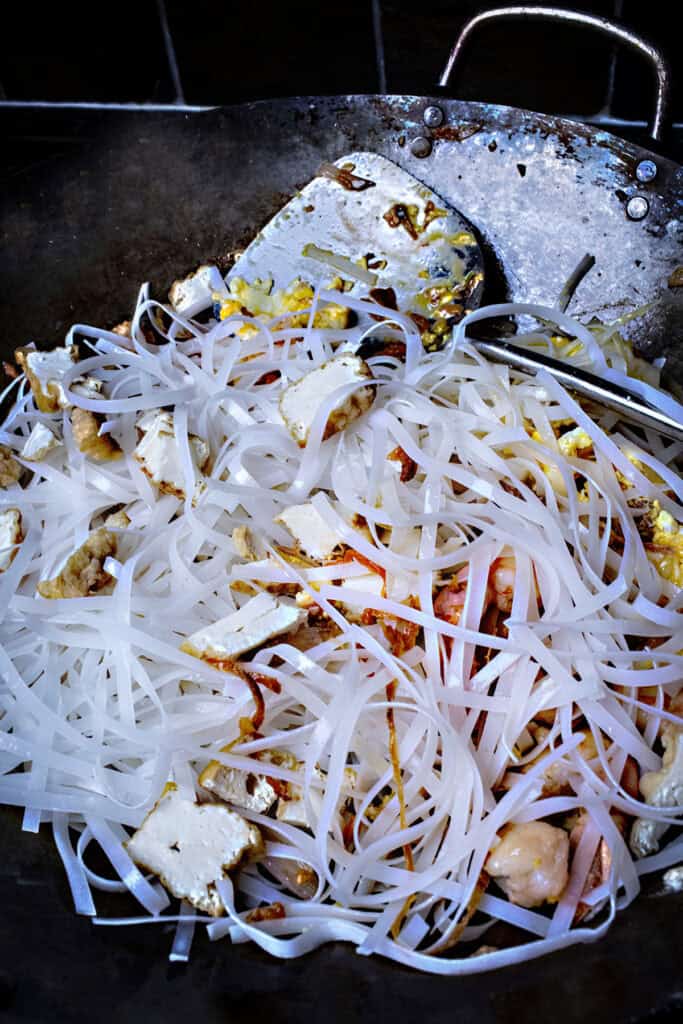
Step 6: Add the Pad Thai Sauce. Pour in the Pad Thai sauce, stirring thoroughly to coat the noodles. Cook for 2-3 minutes, allowing the noodles to absorb the sauce and soften. Spread them out as much as possible to prevent sogginess.
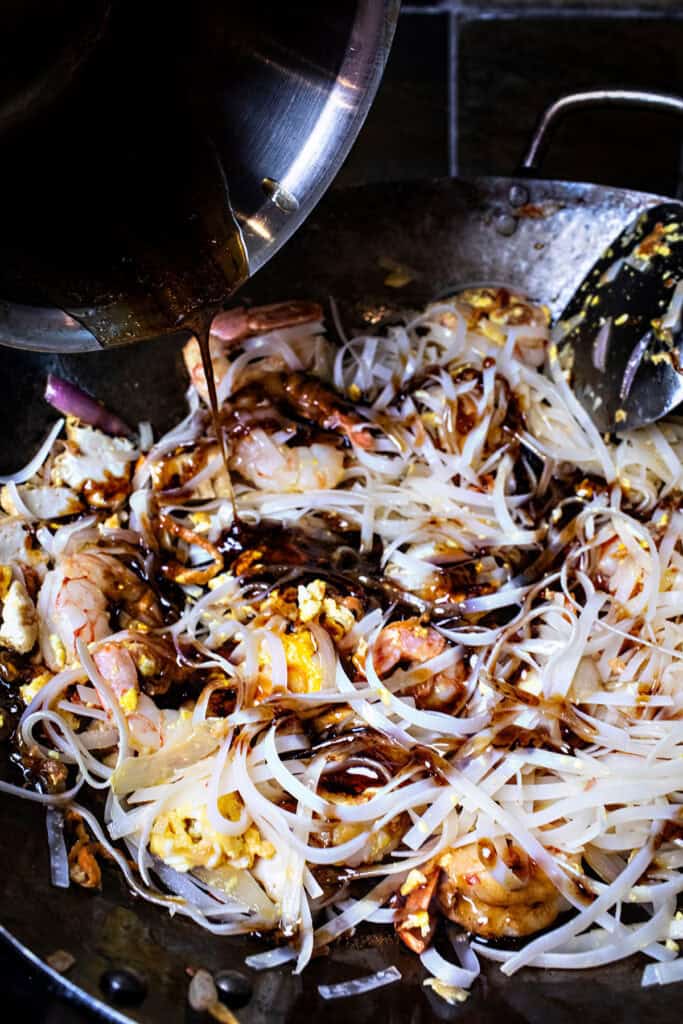
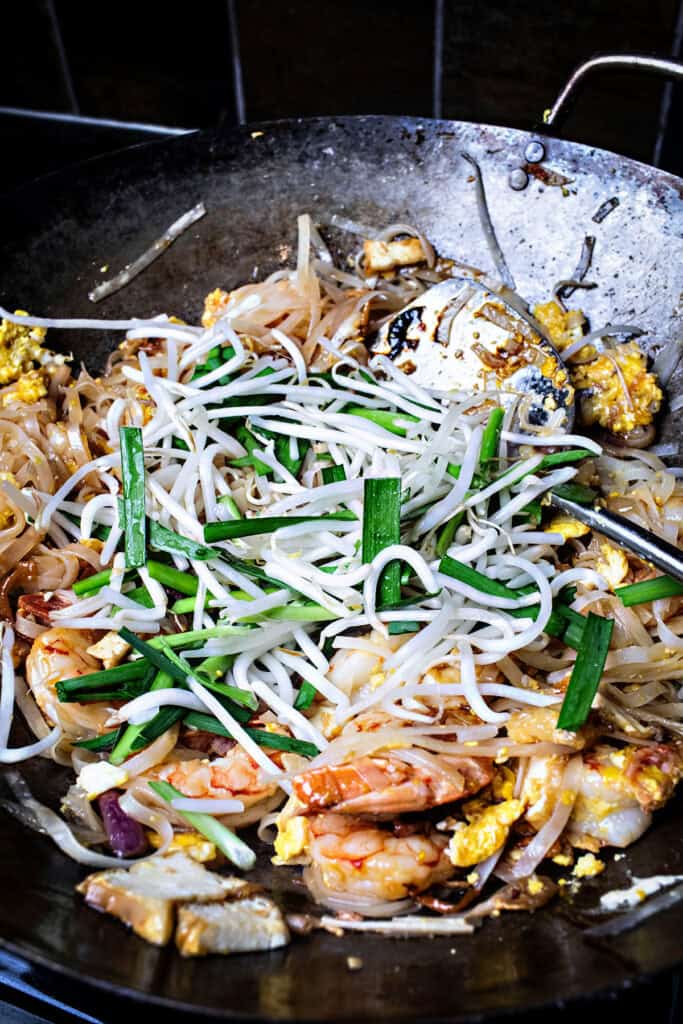
Step 7: Add the Final Ingredients. Add most of the bean sprouts, garlic chives (reserving a few for garnish), and half of the crushed peanuts. Give it a gentle stir. Taste and adjust the flavors with fish sauce, sugar, or a squeeze of lime juice. Add a dash of chili powder if you like it spicy.
Serve and Enjoy!
Plate your beautiful Pad Thai, garnishing with chili flakes, extra peanuts, and bean sprouts. Dig in, share if you can, and savor every delicious bite!
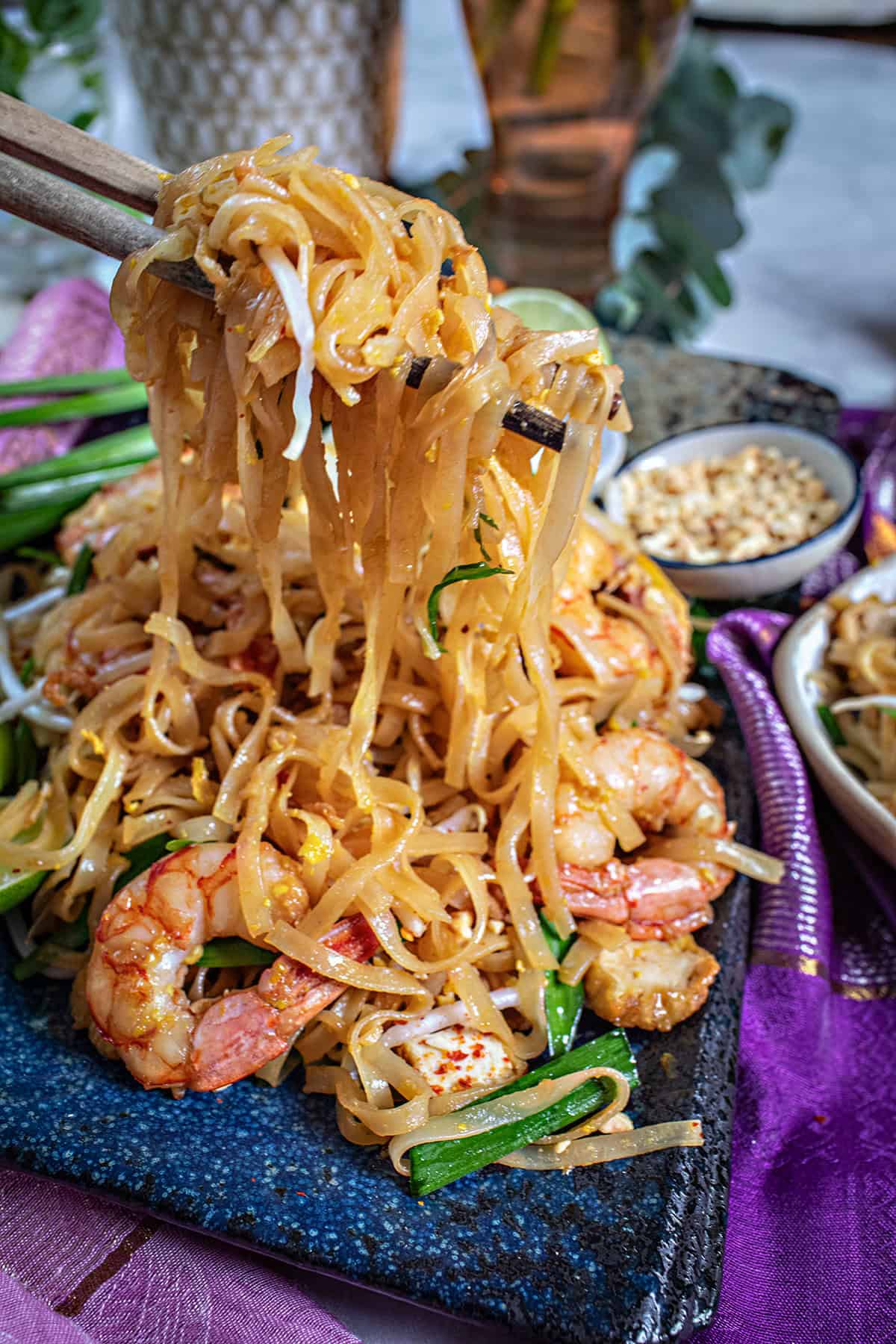
Authentic Pad Thai Tips
- Noodles: If fresh rice noodles are used, soak briefly in water until just al dente. Fresh noodles are easier to cook, taste better, and are quicker to prepare than dried noodles. Find them in the refrigerated section of Asian markets. Soak in hot water per package instructions for dried noodles, but avoid over-soaking to keep them from getting mushy.
- Tamarind Sauce: Use tamarind pulp or buy pre-made tamarind sauce from an Asian market. This ingredient gives Pad Thai its authentic tang.
- Key Ingredients: For true Pad Thai flavor, don’t skip fish sauce, preserved radish, dried shrimp, or tamarind pulp. You can substitute palm sugar with brown sugar, but avoid replacing the other ingredients if you’re aiming for an authentic taste.
- Preserved Radish: If you’re new to its strong flavor, slice it finely. As you get accustomed, experiment with larger pieces for a richer taste.
How to serve Pad Thai
Serve Shrimp Pad Thai hot, garnished with fresh bean sprouts, crushed peanuts, lime wedges, and green onions or chives. Add a kick with chili flakes and a squeeze of lime for extra tang. Perfect as a one-dish meal or served family-style on a large platter with small bowls of garnishes for customization. Enjoy with chopsticks or a fork to savor the soft, flavorful noodles!
Frequently Asked Questions
No. Although there are many versions and adaptations of Pad Thai, authentic Pad Thai should not contain cilantro.
Authentic Pad Thai sauce is made with palm sugar, fish sauce, and tamarind concentrate, never soy sauce, chili-garlic sauce, or other sauces.
Sugar is used in Pad Thai sauce. Typically, palm sugar is used, but other types of sugar, such as brown, white, or monk fruit sugar, are also used for the sweet taste.
Shrimp is a common protein used in Pad Thai recipes because it cooks faster, and the meat doesn't diminish the unique flavors. However, the recipe is adaptable, and other meat and vegetables can also be used.
More Thai Recipes You'll Love
- Pad Mee, A super simple version of rice noodles stir fry
- Easy Drunken Noodles, Pad Kee Mao
- Spicy Pad Mee Korat, my personal favorite
- Easy Authentic Shrimp Pad Thai Recipe
- Easy Beef pad Thai without tamarind
- Pad Mee, Vermicelli Thai Rice Noodles
- Pad Woon Sen Noodle Stir Fry Recipe, ผัดวุ้นเส้น
- Thai Drunken Noodles,(Pad Kee Mao)
- Kaffir lime leave and substitute
** Love a recipe you've tried? Please leave a 5-star rating in the recipe card below and a review in the comments section further down the page. Or follow me on Facebook, Pinterest, or Instagram! **
Print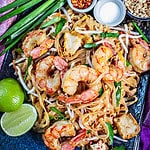
Shrimp Pad Thai Recipe (Authentic)
- Total Time: 30 minutes
- Yield: 4
- Diet: Gluten Free
Description
Growing up in a small Thai village, I learned to make Pad Thai the way my family and neighbors did—using simple ingredients and balancing flavors just right. This shrimp Pad Thai recipe is like a taste of home for me, and I’m excited to share that same feeling with you. It’s authentic, easy to make, and full of the flavors I grew up with.
Ingredients
Pad Thai Sauce
- 4 tablespoons palm sugar (or 3 ½ tablespoons brown sugar to substitute)
- 2 tablespoons fish sauce
- 2 ½ tablespoons tamarind concentrate
For the Pad Thai
- 12 oz soft/fresh Pad Thai noodles or 5 ounces dried rice noodles. See instructions for preparation notes.
- 5 tablespoons oil, divided.
- 8 ounces raw shrimp, deveined, shell and tails removed.
- 5 cloves garlic, roughly chopped
- 1 large shallot, thinly sliced. (Around 2 ounces)
- 2 tablespoons dried shrimp
- ¼ cup or ½ ounce preserved or pickled radish, thinly sliced. See the image and ingredient notes above
- 3 ounces deep-fried tofu, thinly sliced into 1-inch pieces.
- 2 eggs or 3 small ones,
- 1 ½ cups bean sprouts. Save a small handful for garnishing
- ½ cup garlic chives, chopped into 1 ½-inch piece
- 3 tablespoons crushed peanuts, divided. Save some for garnishing.
For Garnishing (as desired)
- Chili pepper flakes
- Crushed peanuts
- Granulated sugar
- Lime wedge
Instructions
-
Prepare the Noodles. Soak fresh noodles in a large bowl of water until they’re soft. Drain and set aside. If you’re using dried noodles, follow the package instructions—they usually need to soak in hot water to soften. Check out my tips below for avoiding mushy noodles! For this recipe, I used fresh noodles (see my preferred brand below).
-
Make the Pad Thai Sauce. In a small saucepan, combine palm sugar and fish sauce over medium-high heat, stirring until the sugar dissolves. Add tamarind paste, bring to a gentle boil, then remove from heat and let cool. Set aside for later.
-
Sauté the Aromatics. Heat a wok or large skillet over medium-high heat, adding oil once hot. Sauté garlic, shallots, dried shrimp, and pickled radish for 1-2 minutes, until fragrant and lightly golden. Add the tofu and stir-fry briefly to crisp it up slightly.
-
Cook the Protein. Add the shrimp to the wok and cook for about 2 minutes until they turn pink. Move everything to one side of the wok, add a bit more oil, and crack in the eggs. Lightly scramble them, letting them cook until they’re just set, keeping them in chunky pieces to add some texture.
-
Add the Noodles. Toss in the soaked rice noodles, stirring well to combine everything. Let cook for about 2 minutes, make sure the noodles are spread out to avoid clumping.
-
Add the Pad Thai Sauce. Pour in the Pad Thai sauce, stirring thoroughly to coat the noodles. Cook for another 2-3 minutes, allowing the noodles to absorb the sauce and soften. Spread them out as much as possible to prevent fogginess.
-
Add the Final Ingredients. Add most of the bean sprouts, garlic chives (reserving a few for garnish), and half of the crushed peanuts. Give it a gentle stir. Taste and adjust the flavors with fish sauce, sugar, or a squeeze of lime juice. Add a dash of chili powder if you like it spicy.
Serve and Enjoy!
Plate your beautiful Pad Thai, garnishing with chili flakes, extra peanuts, and bean sprouts. Dig in, share if you can, and savor every delicious bite!
Notes
- Noodles: If using fresh rice noodles, soak briefly in water until just al dente. Fresh noodles are easier to cook, taste better, and are quicker to prepare than dried noodles. Find them in the refrigerated section of Asian markets. For dried noodles, soak in hot water per package instructions, but avoid over-soaking to keep them from getting mushy.
- Tamarind Sauce: Use tamarind pulp or buy pre-made tamarind sauce from an Asian market. This ingredient gives Pad Thai its authentic tang.
- Key Ingredients: For true Pad Thai flavor, don’t skip fish sauce, preserved radish, dried shrimp, or tamarind pulp. You can substitute palm sugar with brown sugar, but avoid replacing the other ingredients if you’re aiming for authentic taste.
- Preserved Radish: Slice it finely if you’re new to its strong flavor. As you get accustomed, experiment with larger pieces for a richer taste.
- Prep Time: 15
- Cook Time: 15
- Category: Noodles
- Method: Stir fry
- Cuisine: Thai

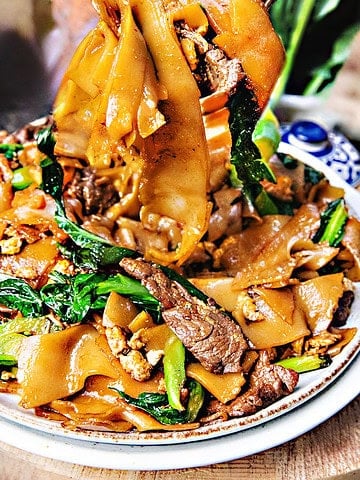
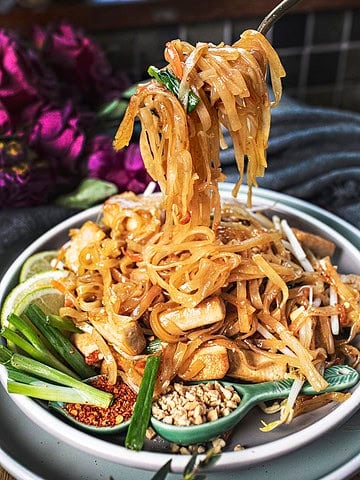
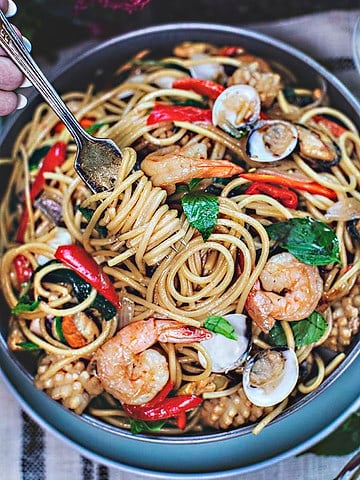
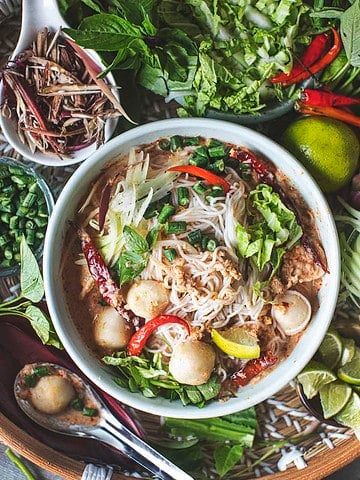
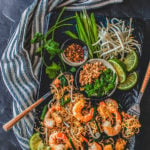
Colt Christensen says
My girls crave this dish! Suwanee’s instructions are clear and easy to follow, even for an amateur cook. We have this recipe in our dinner rotation to stay. 👍
Silvia Jorgensen says
Fabulous! Once you have the ingredients in front of you, it is easy to make and so worth it!!! Best dish ever.
Mark says
I could eat this three times a day everyday!
Suwanee says
THANK YOU!! I'm so humbled and honored!
Alice Koh-Sorey says
This is the ABSOLUTE BEST Phad Thai recipe I have ever tried and tested. Suwanee doesn't stinge on ingredients, which result in the most delightful Phad Thai eating experience. My husband and I love this noodle dish and this recipe is by far the most delicious one I've ever eaten. It is far superior than most eateries in Thailand!
Katherine Wolstenholm says
Loved how easy it was to put together! Most of the work is just prepping ingredients. I was able to find all the ingredients at the Asian grocery store. Flavor was delicious! I can’t wait to try to make it again. Thank you, Suwanee!
Teoh says
Pad Thai! This recipe is always a hit at home. It has all the right flavours, seems so simple yet can also satisfy some v picky eaters. I’d also like to say thanks to Suwanee for placing all her ingredients in one photo. I always scan that first to determine the level of effort needed. Thanks Suwanee and keep the recipes coming. Your recipes are so true to Thai tastes. Love it!
Bernadette Sevajee says
The best Pad Thai recipe ever. I’ve tried so many pad thai dishes in Malaysia and even in Thailand but nothing has come close to the perfection of this recipe. It has the perfect blend of sweet, sour and a touch of spiciness. A must try recipe if you r a pad Thai fan.
Ashley Stoll says
Mouth watering simple meal that for sure is a crowd pleaser in my family. Thank you for sharing your delicious recipes ❤️
Brindha says
My fav pad Thai recipe of all
Times. I find that in restaurants sometimes the sweetness of off putting but Suwanee’s recipe has the perfect blend of flavors
Angela says
I love Pad Thai and this recipe didn’t disappoint!! ❤️❤️❤️